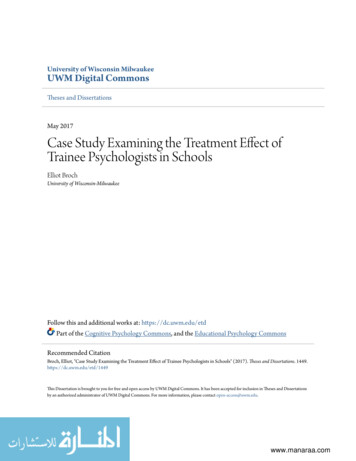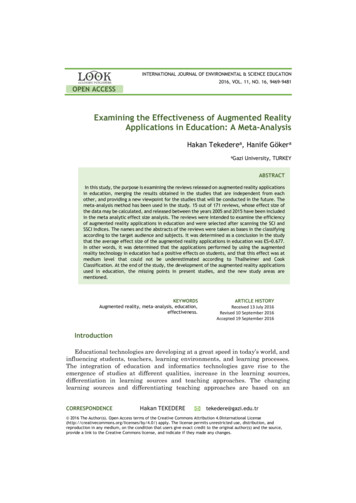
Transcription
University of Wisconsin MilwaukeeUWM Digital CommonsTheses and DissertationsMay 2017Case Study Examining the Treatment Effect ofTrainee Psychologists in SchoolsElliot BrochUniversity of Wisconsin-MilwaukeeFollow this and additional works at: https://dc.uwm.edu/etdPart of the Cognitive Psychology Commons, and the Educational Psychology CommonsRecommended CitationBroch, Elliot, "Case Study Examining the Treatment Effect of Trainee Psychologists in Schools" (2017). Theses and Dissertations. 1449.https://dc.uwm.edu/etd/1449This Dissertation is brought to you for free and open access by UWM Digital Commons. It has been accepted for inclusion in Theses and Dissertationsby an authorized administrator of UWM Digital Commons. For more information, please contact open-access@uwm.edu.www.manaraa.com
CASE STUDY EXAMINING THE TREATMENT EFFECT OF TRAINEE PSYCHOLOGISTSIN SCHOOLSbyElliot L. BrochA Dissertation Submitted inPartial Fulfillment of theRequirements for the Degree ofDoctor of Philosophyin Educational PsychologyatThe University of Wisconsin-MilwaukeeMay 2017www.manaraa.com
ABSTRACTCASE STUDY EXAMINING THE TREATMENT EFFECT OF TRAINEE PSYCHOLOGISTSIN SCHOOLSbyElliot L BrochThe University of Wisconsin-Milwaukee, 2017Under the Supervision of Professor Kyongboon KwonThe effects of school- based therapy carried out by trainee psychologists were examined in foururban schools (k4-8th grade) in socio economically disadvantaged neighborhoods. Additionally,the treatment effects were compared between students serviced by trainees compared to thosereceiving treatment from licensed professionals. Trainee psychologists obtained moderate effectsizes (equivalent to that procured by licensed professionals) on measures of social emotionalfunctioning. Discipline problems did not increase or decrease at a different rate for thosereceiving counselling from trainees and licensed professionals compared to their same agecounterparts. Although students receiving therapy from trainees and licensed professionals madeacademic progress in reading and math commensurate with their peers, those receiving therapyfrom licensed professionals evidenced a larger improvement on measures of reading than thosereceiving services from trainees. In addition, students with less severe initial symptoms mademore progress compared to those with severe symptoms. Progress in reading and math was alsohigher for younger students compared to older students.iiwww.manaraa.com
Tomy parents,my wifeand my childreniiiwww.manaraa.com
TABLE OF CONTENTSAbstract .iiDedication .iiiList of Tables .viIntroduction .1Literature Review .5Efficacy of trainees and professionals working with adults .5Psychotherapy with children and adolescents .18Efficacy of Professionals and Trainees Working with Children .20School based mental health 25Relationship between mental health services and academic progress .28Outcomes for School based mental health .30Efficacy of trainee therapists in the schools .32Group versus individual therapy: Implications for trainees .35Research Questions and hypotheses .39Method .41Participants .41Research design .42Therapists .42Measures and variables .43Procedure .48ivwww.manaraa.com
Results 51Descriptive statistics 51Intervention modality 56Results for hypothesis 1 .58Results for hypothesis 2 .60Discussion .68Summary of Findings 69School based mental health 69Difficulties implementing mental health services in a School Setting .73Trainee factors .74Group versus individual therapy 77Child characteristics. 78Implications 84Limitations and future research .87References .92AppendicesAppendix A: Notice of IRB Approval . 109Appendix B: Strengths and Difficulties Questionnaire .110Appendix C: Session Summary example .111Curriculum Vitae .112vwww.manaraa.com
LIST OF TABLESTable 1. Mean and standard deviation scores for pre and post-test measures by therapist type.53Table 2. Correlations between outcome variables for pre and post outcome measures 54Table 3. Mean and standard deviations of difference scores for variables by therapist type .62Table 4. Analysis of Covariance and Least Squares Means for SDQ .63Table 5. Analysis of Covariance and Least Squares Means for Discipline Referrals. . 64Table 6. Analysis of Covariance and Least Squares Means for Reading 66Table 7. Analysis of Covariance and Least Squares Means for Math . 67viwww.manaraa.com
Case Study Examining the Treatment Effect of Trainee Psychologists in SchoolsIntroductionChildhood and adolescence is a period of pronounced development across physical,cognitive, behavioral, social and emotional dimensions. However, it is also a time of significantvulnerability to the influences of stress, negative influences from families and peers, and thebeginning of mental illness. The large number of children in the United States suffering frommental health difficulties has become progressively more evident (National Institute for HealthCare Management Foundation [NIHCMF], 2005, Perou et al 2013). Mental health problems ormental disorders, if unrecognized and untreated can lead to significant deleterious consequencesincluding school drop-out (Breslau et al. 2011), poor social relationships (Bhatia, 2007), lessvocational success, justice system contact and early mortality (O’Connel et al., 2009). There issubstantial evidence for the efficacy of treatment of mental disorders in young people andoutcomes are more likely to be favorable if evidence based treatment is provided early in thecourse of the mental health disorder (Rutter et al., 2008, Kutcher et al., 2011).Estimates range as high as 20% of community populations experiencing emotional andbehavioral difficulties and the majority of youth with mental health problems go untreated(Merikangas et al, 2011, Romero et al., 2014). Furthermore, in large urban schools, someresearchers have noted a greater concern, in that it has been estimated that over 50% of childrenattending these schools demonstrate significant social emotional and learning difficulties (Centerfor Mental Health in Schools, 2008). Related to this recognition, the School Mental HealthInternational Leadership Exchange (SMHILE) is bringing together leaders from regions andcountries across the world to exchange ideas, create dissemination and leadership strategies and1www.manaraa.com
to help promote the best research, policy, and practice directions for the field (Short, Weist, &McDaniel, 2014). A critical challenge is to convince policy makers of the value of mental healthin schools. For example, school leaders may not support this agenda based on the view thatschools should not be in the “mental health” field and with the concerns of taking on aresponsibility that will be burdensome in terms of resources and cost. In addition, educationadministrators emphasize academic success, but may not see the potential of positive mentalhealth functioning in contributing to this success (Kutcher, Wei, & Weist, 2015). Recently, aWorld Health Organization report (Suhrcke and De Paz Nieves, 2011) highlighted the need toshift perspectives from viewing improved mental health as a product of education, to seeing it asa factor that determines educational outcomes.Wei & Kuther (2012) report that a challenge faced by many countries is to provideadequate human resources for delivery of education services let alone essential mental healthinterventions. Unfortunately, even in developed countries the resources are not adequate. Forexample, a survey of school mental health programs administered in the United States suggestedthat more than 70% of district leaders reported an increase need for services, while concurrentlyexperiencing decreasing funding levels (Foster et al, 2005). Given these realities, new strategiesfor providing mental health services to students such as engaging primary care facilities,community based programs (recreation centers) and empowering non-specialist providers, suchas healthcare workers, caregivers, teachers and others have been suggested (Wei & Kutcher,2012).2www.manaraa.com
Stepped Care ModelsAnother approach to address the gap between the high demand for mental health servicesand the limited availability of counsellors or therapists is stepped care models. The stepped caresystem design essentially involves offering patients treatment at different ‘steps’, with theintensity of treatment increasing at each step if they fail to benefit at previous steps (Richards etal, 2012). For clients presenting with common mental health problems the majority of themwould be offered some form of low intensity treatment first under the stepped care design. Thosethat do not improve are then referred on to higher intensity interventions. Examples of lowintensity treatments for common mental health problems include group sessions, computer basedtreatment and guided self-help treatments. Low intensity treatments usually incorporate just afew sessions with a para-professional mental health worker (Bennett-Levy et al, 2010). Highintensity treatments such as cognitive behavior therapy usually take the form of one-to-onetreatment sessions between a licensed mental health professional and the patient and are spreadover a number of weeks or months. The basic incentive to introduce stepped care approaches tothe organization of mental health services for common mental health problems is that lowintensity treatments are often both effective and less costly. Access to low-intensity forms oftreatment may reduce the need for more expensive treatments for many clients, while increasingaccess to more involved forms of treatment for those that require it (Cuijpers et al, 2010). Thesemodels are all united under the same goal; to increase service utilization efficiency to meet thegrowing mental health service demands.3www.manaraa.com
Use of Trainee TherapistsOne form of stepped care is the use of supervised trainee therapists to increase treatmentaccess. An important relationship has existed between providers in health care clinics andgraduate students seeking essential practical experience (Boggs & Dounce, 2000). Training sitesenable trainees to learn new techniques, refine their skills, and to receive supervision. In return,training sites receive free or low cost therapists who increase the capacity of the clinics to meetthe overwhelming service demands (Nyman et al., 2010). In the recent difficult fiscalenvironment, the use of graduate students and trainees in the implementation of mental healthservices has become so commonplace that few question the practice (Constantine & Gloria,1998, Nyman et al., 2010). In addition, graduate students and trainees are progressively beingcalled upon to help provide services to populations that lack access to mental health care such asin rural areas (Rishel & Hartnett, 2015) or with underserved minority students (Grossman et al,2007). However, it is essential that the relationship remain symbiotic. Trainees must receiveindispensable practical training, but clients are also entitled to comprehensive and efficacioustreatment. In fact, it would not be ethical to allow students “to practice” on clients unless theservices can be shown to benefit those undergoing therapy. The degree to which trainee-providedservices are efficacious remains an empirical question.The current study examined the outcomes associated with trainee psychologists.Additionally, it compared the outcomes of trainee psychologists to licensed professionalsoperating in schools. It also attempted to provide insight into factors that might play a role in theeffectiveness of trainees (age of students, level of severity, type of presenting problems etc.).4www.manaraa.com
Literature ReviewConsistent with the literature on psychotherapy in general, more research has beenconducted examining trainee therapists’ efficacy with adult populations than with children andadolescents (Kazdin, 2003). Therefore, this literature review first reviews the pertinent studiescarried out with adult populations and the insights gleaned and then concentrates on the child andadolescent literature. Finally, research pertaining to trainees operating in schools will bediscussed and how this relates to the current study.Efficacy of Professional and Trainee Therapists Working with AdultsThe broad findings of therapy across a range of treatments for a variety of disorders,suggests that psychotherapy for the adult population evidences medium to large effect sizes(Lambert, 2013). Psychotherapy has been found to be more effective than many evidence basedmedical practices, some of which are costly and cause significant side effects (Wampold, 2007).The first review comparing the effectiveness of professionals and paraprofessionalstreating clients with a variety of services was carried out by Durlak in the late 1970’s. Durlak(1979) reviewed 42 studies that compared the outcomes of paraprofessionals with professionalsacross a number of domains, including individual and group psychotherapy , crisis counselling,behavior modification, social and vocational rehabilitation, and academics-adjustment andmental health related services. Professionals were defined as those individuals with postbaccalaureate, formal clinical training in professional programs of psychology, psychiatry, socialwork, and psychiatric nursing. Counsellors without these credentials were categorized asparaprofessionals. Durlak (1979) reported that 28 studies indicated no difference in outcomesbetween professionals and paraprofessionals, 12 studies favored paraprofessionals, and only 25www.manaraa.com
studies favored professionals. This review suggested that paraprofessionals could perform equalto, or outperform their better-trained counterparts.A number of criticisms against the early reviews have been advanced. Firstly, to test thedifference between professionals and paraprofessionals in a meaningful manner, one must ensurethat there are no other confounding factors. However, different types of treatment modalities andvarious characteristics (e.g. age, length of treatment) were found to vary systematically betweenthe professional and paraprofessional groups. The type of definitions used to designate therapistsinto professional or paraprofessional was somewhat arbitrary considering that in 25% of thestudies graduate students were considered professionals. Furthermore, some studies focused onvocational counselling instead of psychotherapy (Nietzel & Fisher 1981). These issues made itdifficult to come to any conclusion.Later reviews (Atkins & Christensen, 2001; Stein & Lambert, 1995 Chris-Christoph etal,. 1991) which incorporated more rigorous inclusion criteria produced somewhat differentresults. Chris-Christoff et al (1991) analyzed the effects of therapist experience across a selectgroup of studies that specifically addressed outcomes associated with specific treatmentapproaches. Findings suggested that therapist experience was positively correlated withtreatment outcomes, especially when manualized interventions were used. Stein & Lambert(1995) reviewed 36 studies and found that different levels of training and experience led todifferences in outcomes. They limited their inclusion to psychotherapy, excluding research thatincluded vocational counselling and academic advice related to educational difficulties orlearning problems. The results suggested a modest but consistent treatment effect size favoringtherapists who had more training. Additionally, three well controlled studies (included in thereview) suggested that independent clinicians tend to evaluate clients of more trained and6www.manaraa.com
experienced therapists as somewhat more improved compared to clients of less trained andexperienced therapists. In addition, Stein & Lambert (1995) reported that studies with largersample sizes tended to demonstrate larger effect sizes favoring more experienced therapistscompared with studies that used a smaller sample size. Finally, it was found that therapists whohad not attended graduate school and who worked in community mental health centers andclinics were more likely to produce higher premature dropout rates than their better trainedcounterparts (Stein & Lambert, 1995).Atkins & Christensen (2001) examined a number of factors and inconsistencies that seemto have contributed to the lack of consistency in reviews. The lack of a unified definition ofprofessionals or paraprofessionals, (allowing for similar groups such as graduate students to becategorized as either) resulted in each group representing a very heterogeneous entity. While notpossessing a professional degree, paraprofessionals are usually not untrained or inexperienced.Many may have had years of experience working with a particular population or may havereceived specialized training as part of a study. Related to this issue, professionals may also varyin their level of degree or amount of experience. Doctoral level professionals (PhD, MD) werenormally assigned the same code, even though their experiences in delivering mental healthservices could range from a few months to many years. In addition, many studies do not reportthe level of supervision received or consultation provided. It is likely that younger or less trainedtherapists could have received greater supervision and consultation than that received by moreexperienced therapists. Despite these methodological problems and ambiguities, Atkins &Christensen (2001) concluded that the existing research supports the efficacy of untrainedtherapists. However, trained therapists were shown to have superior outcomes in specific areas,such as greater client retention, briefer therapies, and better overall well-being of the clients.7www.manaraa.com
The relationship between level of clinical experience and therapeutic outcome in timelimited therapy was evaluated by Burlingame et al (1989). Experienced therapists and traineesconducted time limited therapy with a prescreened homogenous group of clients. Fifty sevenclients at a university counselling center were selected using a structured interview with clients.Clients had to meet predetermined inclusion criteria( ability to form a therapeutic relationship,having a specific definable problem, one successful relationship in the past, good premorbidhistory) and exclusion criteria (severe depression, acute psychosis, borderline personalitydisorder, anger as a main problem, lack of a consistent sense of self-identity, unrealisticexpectations of therapy). Twelve therapists (6 interns with 1-5 years of experience and 6 licensedstaff with 4-15 years of experience) were randomly selected from a pool of staff volunteers froma university counselling clinic and were randomly assigned to 3 training conditions (no trainingin brief therapy, self-instruction, and intensive training in brief therapy). Clients were randomlyassigned to therapists for 8 sessions of time limited therapy. Clients of experienced therapists hadconsistently superior outcomes compared to clients of their less experienced colleagues. Inaddition, the study also found that the rates of client improvement paralleled the intensity oftherapist training irrespective of therapist experience. Therapists who received greater training intime limited therapy evidenced superior outcomes and this pattern did not differ across the twoexperience conditions. Thus, experienced and less experienced therapists equally benefited fromspecific training in time limited therapy. This study revealed that amount of therapist experienceas well as type and intensity of training are important predictors of client outcomes. In addition,the researchers suggested the skills needed for time limited therapy may be qualitatively differentthan those needed for general therapy (hence the benefit accrued to both inexperienced andexperienced therapist from training). It must be noted, that the clients in this study were8www.manaraa.com
homogenous and controlled; thus, they may not be characteristic of clients in regular clinics andhospitals. In addition, the therapists used in this study from a university counselling center maybe dissimilar enough from therapists in general practice so results may not be generalizable.Furthermore, short term therapy could be markedly different from regular therapy in terms offavoring experienced therapists.Driscoll et al (2003) carried out a study at a university run outpatient clinic that attemptedto better define level of training and experience (Client contact hours). Participants (raciallyrepresentative sample of community in Tallahassee Florida, N 83), were assigned to traineetherapists based on availability in a therapists caseload. Based on the diagnosis (which variedwidely), clients were treated using empirically validated treatments (cognitive therapy, exposuretreatments for anxiety disorders, dialectical behavioral therapy etc.). The clinic was the firstplacement for doctoral students in the clinical psychology program at Florida State Universityand trainees saw approximately 4 clients per week and received 3 hours a week of supervisionfrom a clinical psychologist, and 2 hours per week in staff conferences devoted to casepresentations and intensive instruction for empirically validated treatments. Multiple regressionanalysis suggested that trainee experience (even when controlling for therapy dose or number ofsessions, and initial severity) was positively correlated with treatment outcome. In fact, traineeexperience accounted for 71% of the variance in outcome. The experience of practicum studentsappeared to have a positive influence on treatment outcome across a variety of diagnoses. Theseresults suggest that time, experience, and supervision leads to therapists’ skills becoming moredeveloped and more effective. Since previous studies have operationalized the therapistexperience variable in terms other than actual hours of client contact, the results of this studyseem to suggest the possibility that the positive relationship between trainee experience and9www.manaraa.com
client outcome may have been masked due to the imprecise definitions of experience. Aprominent feature of the present study is related to their use of manualized and empiricallysupported treatments. It must be considered, that trainees do not improve merely due to timemeeting with clients, rather through the combination of direct experience in conjunction withpractice using therapies that have been shown to work for respective client issues. Thus, thosewho learn the manuals and engage in protracted practice will perform better than those who donot. This could also explain why some previous studies that did not use manualized orempirically supported treatments demonstrated little to no differences in outcome as a functionof therapist experience. Perhaps both more and less experienced therapists will perform equallywhen therapy is unstructured or therapists use strategies lacking rigorous evidence for theirefficacy. Overall, this study emphasizes the importance of training and experience on clientoutcomes and suggests the need to examine trainee competence before working with clients.Trainees with more experience seem to achieve greater outcomes than trainees with lessexperience. However, the authors only used one outcome measure that was completed by thetrainee therapists themselves. Although the measure is widely used and has adequatepsychometric properties (i.e., interrater agreement), the measure may only account for thetrainees conceptualization of client functioning and may be subject to bias. In addition, the studycompared level of experience within the category of trainees. Perhaps the pattern would bedifferent if all categories of proficiency and experience were included (trainees, professionalsetc.).Outcomes of a manualized cognitive behavioral therapy with acceptance andcommitment therapy using 14 novice therapists that were treating 28 undiagnosed clients at auniversity clinic in Finland was investigated by Lappalainen et al (2007). The length of the10www.manaraa.com
therapy was approximately 10 sessions. The trainees received 20 hours of diagnostic andintervention theory and 30 hours of group supervision (3 hours a week). Results indicated thatthe trainees achieved a large effect size using the acceptance and commitment therapy (ACT)and a small effect size using the cognitive behavioral therapy. Results suggest that even withlimited exposure to the therapeutic approaches, trainee therapists could produce positivechanges. Counterintuitively, the trainee therapists effected greater change when usingAcceptance and Commitment therapy than when using traditional Cognitive Behavioral therapyeven though they had received more training and supervision for Cognitive Behavioral Therapy(CBT). Perhaps CBT takes longer to master and apply than does the ACT. This seems to suggestthat trainee therapists can learn new techniques and effect change with clients although the effectsizes achieved were not as great as that found for experienced therapists. The researchers notethat the sample size, and sample composition (Majority women), may limit the generalizabilityof the results to other settings. This study again emphasizes the importance of considering levelof training and experience when deciding the allocation of clients to trainees.Bados, Balguer, & Saldana (2007) conducted a study to examine the efficacy of traineetherapists treating patients ( 59 patients, 42% were students or staff) presenting with anxietydisorders at the Behavioral Therapy Unit of the University of Barcelona using cognitivebehavioral therapy. The authors concluded that the large effect size (1.09), suggests thatcognitive behavioral therapy applied by trainee therapists under conditions of standard clinicalpractice is effective. However, the pre-post effect size was slightly lower than those observed inother Spanish studies and in international meta-analyses. In addition, the percentages of clientswho improved or recovered were slightly lower than those reported in reviews of anxietydisorders. Results also indicated that the trainees needed twice as many hours of treatment to11www.manaraa.com
achieve the same outcome and the drop-out rate (33%) was higher than those reported in othermeta-analyses. The authors suggested that the lower efficacy in the study might be becausetherapy was administered by trainees. In addition, results could be due to the contrast betweentreatment conducted in artificial contexts and the current study reflecting standard clinicalpractice (i.e. therapists seeing fewer cases, selected clients etc.). This same conclusion wasreached by Ryum, Stiles, & Vogel, (2007) who also reported that therapy provided by graduatestudents in Norway produced effect sizes in the medium range, but few clients met criteria forreliable and clinically meaningful change. This reveals that therapists in training may notperform as well as experienced therapists. The above studies suggest that clinicians andsupervisors need to consider the ethical ramifications and evidence for using trainees (especiallyinexperienced trainees) to conduct therapy with clients.Forand et al, (2011) carried out a study to assess the effectiveness of CognitiveBehavioral Therapy delivered by a group of trainee therapists in a clinic situated in an urbanacademic medical center. A General outpatient sample with few experimental controls was usedwhich although more generalizable to other outpatient clinics, obviously has decreased internalvalidity. Participants (61.8% Caucasian) were selected from a research database (N 249) , hada diagnosed mood or anxiety disorders and at least three sessions of available symptom data.Therapists in the study were primarily pre-doctoral clinical psychology interns and first andsecond year postdoctoral fellows. Adherence to treatment techniques and principals wasemphasized and supervision was intensive (1 hour of individual, 1 hour of group, 1 hour of groupvideo supervision per week and postdoctoral fellows received 3 hours of individual and 1 hour ofgroup), although treatment was not manualized. Cognitive behavioral therapy delivered bytrainees was found to be effective, with about 48% of the sample meeting criteria for recovery on12www.manaraa.com
standardized measures of depression and anxiety. The interns were found to produce outcomescommensurate with therapists in other outpatient clinics and in randomized controlled trials.When recovery as a function of initial severity was considered, trainees were less effectivecompared to more experienced therapists when treating severe depression. However, rates ofrecovery for anxiety disorders were similar across all levels of initial anxiety severity. This couldbe due to therapist competence mattering less when treating anxiety symptoms (asexposure/behavioral therapy might be less sensitive to variations in therapist skill level) orperhaps diffe
University of Wisconsin Milwaukee UWM Digital Commons Theses and Dissertations May 2017 Case Study Examining the Treatment Effect of Trainee Psychologists in Schools Elliot Broch University of Wisconsin-Milwaukee Follow this and additional works at:https://dc.uwm.edu/etd Part of theCognitive Psychology Commons, and theEducational Psychology Commons










